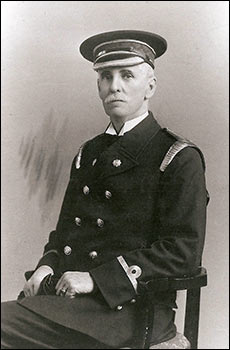 |
|
Captain Fred Knight
|
In the year 1877 the Rushden Fire Brigade was founded with twelve men under the Captaincy of William Foskett. It was started as a result of a public subscription to purchase a Shand Mason Manual fire engine.
William Foskett's Second Officer was Mr Fred Knight who in 1885 was appointed Captain and he served in this position for 35 years.
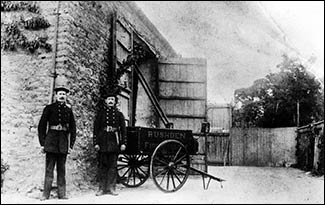 |
|
One of the earlier premises
|
|
The first "Station" was situated in "Butcher Smith's Yard" opposite the entrance to Hall Park on the corner of Griffith Street.
The method of calling the Brigade at that time was to ring the Number 5 bell of St Mary's Church. Compared with today this process was very slow as horses had to be obtained to draw the manual, it was seldom less than half an hour before the turn out.
The Brigade then moved to the High Street opposite West Street. They rented a barn in the yard of Dr. E. J. Freeman at a yearly rent of £7. The horses were kept on the opposite side of the road at the rear of the "Feathers" Public House; they were supplied and driven by the landlord Mr Fred Ette.
|
| Map shows Fire Station behind High Street.
It was close to Fireman Seckington's seeds merchant and nursery ground (trees). He was often called to local fires before the brigade arrived, and with the local people they would start fighting the fire.
The equipment was kept in a barn rented from Dr E J Freeman.
*1892 Fire Brigade Engine - House at the rear of Dr. E. J. Freeman's house, rented from him at £3.10.0. per year.
|
|
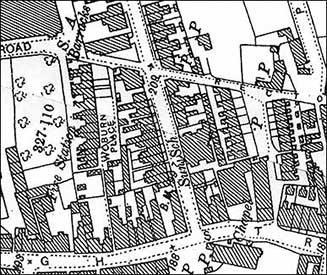 |
|
|
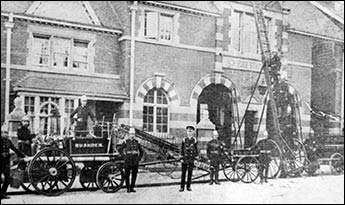 |
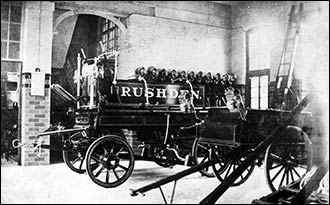 |
|
The various carts and ladders on display c1902
|
Inside the station
|
|
It was from this station in the High Street that the Brigade was turned out to the "Great Fire" of Rushden, the factory of John Caves, on the 19th July 1901, which burned for three days. This factory was the largest in the town and had a workforce of about 1,000 people. It was built in the early 1880s it was of three and four storeys, fitted with all the latest and best machinery, and a row of lock-up premises were built into the High Street side. During the fire the factory was destroyed, alongside with one other factory, one school, sixteen shops and twelve houses were razed to the ground.
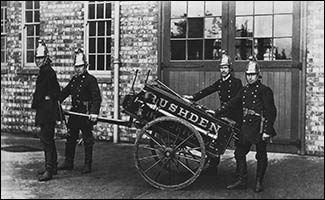 |
|
The Hose Cart
|
|
The firemen were helpless as the only supply of water came from brooks and soft water wells. During 1893 the Captain applied to the Rushden Local Government District Board (which became the Rushden Urban Distinct Council in 1895) for a hose cart and ladders this was approved at the cost of £10 for the former and £4 for the latter. The hose cart was provided with a standpipe, key and bar, and six lengths of hose, enabling the first two Firemen attending the call to get to work whilst the horses were being harnessed.
In 1895 Mr Claude Green was appointed caretaker of the Fire Engine House at the fee of £8 per annum. Claude Green resigned in 1942 after 54 years of service with the Brigade following the setting up of the National Fire Service.
Following the fire in 1901 of Caves it was decided to build a new purpose built Station in Newton Road. The land that the new station and the town depot were built was bought at the cost of £150.
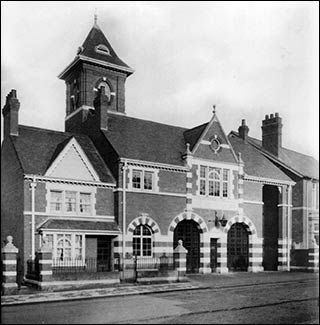 |
|
The Fire Station 1902 - note the arched doorways
|
|
The Fire Station was designed by Mr W B Madin, the Rushden Urban Council surveyor, himself an ex fireman. He designed the handsome Building of red brickwork, Bath stone dressing and roofed with Broseley tiles, the engine house was lined with glazed bricks.
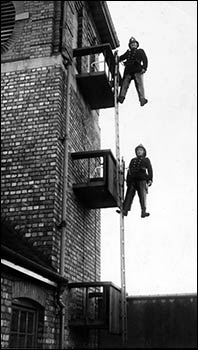 |
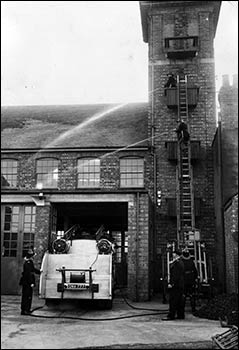 |
|
The tower and back yard of the station
|
|
The hose tower is 47 feet high, the attached cottage was designed to harmonise with the station and had direct access into the station. The station when designed, was many years ahead of its time, in fact except for the alteration of the front doors and the extension at the rear in 1952, the station has hardly changed at all.
The cost of the station was just over £1,575; it was never officially opened, but the firemen moved in, in July 1902.
In 1903 the Station was connected to the National Telephone System with the new electric bells, these were rung by a hand operated generator and rang a bell in the Firemen's houses.
|
 |
|
Captain Albert Percy Timpson
|
|
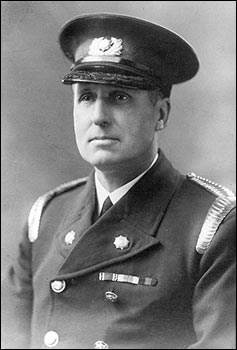 |
|
Captain Robert Knight
|
|
The Shand Mason escape was bought in 1900.
The Shand Mason Steam Fire Engine was bought in 1907.
The Schneider Motor Tender was purchased in 1919 (chassis built in Rushden, where "Netto" is now).
The Dennis "Ace" was purchased in 1927; Mrs Clara Groome of Park Road loaned to the Council £920 for the purchase of this machine.
Mr Fred Knight resigned in 1919 after 42 years service; his son Mr Robert F Knight succeeded him.
Mr Robert Knight resigned in April 1936 and Mr Albert Percy Timpson succeeded him.
Note: If anyone has a photograph of William Foskett, we'd be grateful to take a copy please.
|
The Rushden Echo and Argus, 19th June, 1953
Designed for the horse-drawn era half a century ago, Rushden Fire Station is being enlarged. Meanwhile, the latest type of pump escape which the town has been allocated, is being stored elsewhere in the county because the depth of the building is insufficient. A further 15 feet will be added to the rear of the premises and the present two folding doors at the entrance will be replaced by one of the sliding variety – there is literally not an inch to spare when the water tender now leaves; a fact illustrated by its chipped and splintered doors.
|
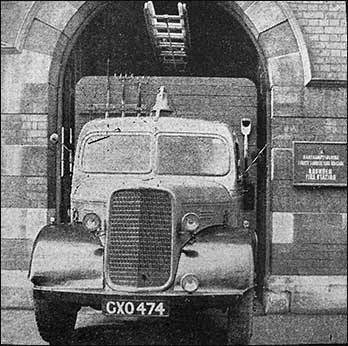 |
|
|
|